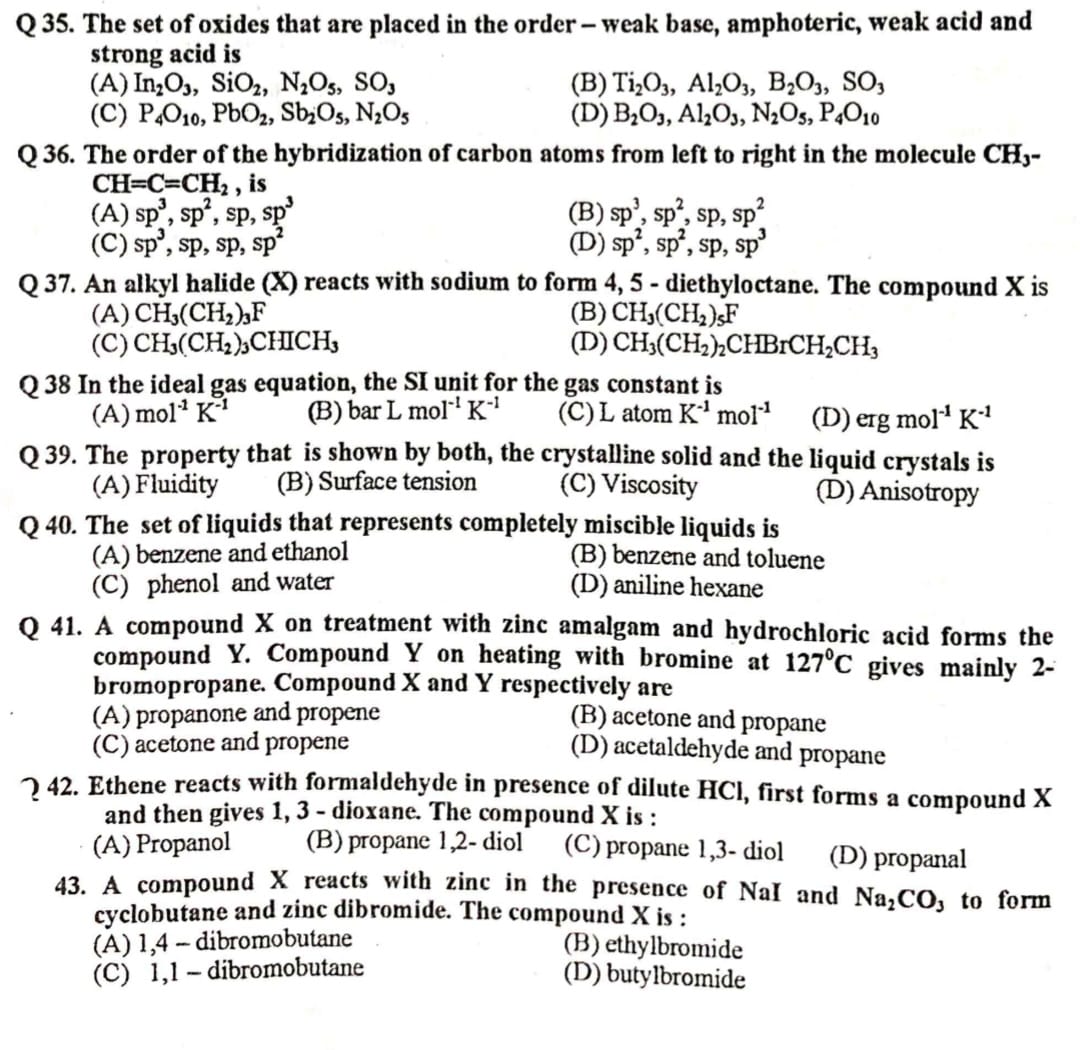The set of oxides that are placed in the order - weak base, amphoteric, weak acid and strong acid is: (A) In2O3, SiO2, N2O5, SO3 (B) TiO2, Al2O3, B2O3, SO3 (C) P4O10, PbO2, Sb2O5,... The set of oxides that are placed in the order - weak base, amphoteric, weak acid and strong acid is: (A) In2O3, SiO2, N2O5, SO3 (B) TiO2, Al2O3, B2O3, SO3 (C) P4O10, PbO2, Sb2O5, N2O5 (D) B2O3, Al2O3, N2O5, P4O10 The order of the hybridization of carbon atoms from left to right in the molecule CH2=CH-CH2- is: (A) sp3, sp2, sp, sp3 (B) sp3, sp2, sp2, sp2 (C) sp2, sp, sp2, sp3 (D) sp2, sp2, sp2, sp3 An alkyl halide (X) reacts with sodium to form 4,5-diethyloctane. The compound X is: (A) CH3(CH2)2F (B) CH3(CH2)5F (C) CH3(CH2)2CHBrCH2CH3 (D) CH3(CH2)2CHBr2 In the ideal gas equation, the SI unit for the gas constant is: (A) mol-1 K-1 (B) bar L mol-1 K-1 (C) L atom K-1 mol-1 (D) erg mol-1 K-1 The property that is shown by both, the crystalline solid and the liquid crystals is: (A) Fluidity (B) Surface tension (C) Viscosity (D) Anisotropy The set of liquids that represents completely miscible liquids is: (A) benzene and ethanol (B) benzene and toluene (C) phenol and water (D) aniline hexane A compound X on treatment with zinc amalgam and hydrochloric acid forms the compound Y. Compound Y on heating with bromine at 127°C gives mainly 2-bromopropane. Compound X and Y respectively are: (A) propanone and propene (B) acetone and propane (C) acetaldehyde and propane (D) acetal Ethene reacts with formaldehyde in the presence of dilute HCl, first forms a compound X and then gives 1,3-dioxane. The compound X is: (A) Propanol (B) propane 1,2-diol (C) propane 1,3-diol (D) propanal A compound X reacts with zinc in the presence of NaI and Na2CO3 to form cyclobutane and zinc dibromide. The compound X is: (A) 1,4-dibromobutane (B) ethyl bromide (C) 1,1-dibromobutane (D) butyl bromide.

Understand the Problem
The questions provided appear to be a set of multiple-choice questions related to chemistry concepts, including acid-base trends, hybridization, alkyl halides, gas laws, properties of liquids, and organic reactions.
Answer
TiO2, Al2O3, B2O3, SO3
The set of oxides that are placed in the order - weak base, amphoteric, weak acid, and strong acid is TiO2, Al2O3, B2O3, SO3.
Answer for screen readers
The set of oxides that are placed in the order - weak base, amphoteric, weak acid, and strong acid is TiO2, Al2O3, B2O3, SO3.
More Information
The order is determined by the general chemical properties of these oxides where TiO2 is weakly basic, Al2O3 is amphoteric, B2O3 is weakly acidic, and SO3 is strongly acidic.
Tips
Common mistake includes misunderstanding the amphoteric nature of Al2O3, often leading to incorrect classification.
Sources
- Acid-base Behavior of the Oxides - Chemistry LibreTexts - chem.libretexts.org
AI-generated content may contain errors. Please verify critical information